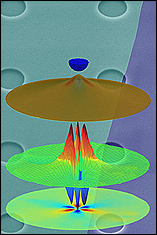Li, Solares Co-author Science Paper on Graphene Drumheads
Assistant Professors Teng Li and Santiago Solares were on a team of researchers that conducted the first study showing that strained graphene confines charge carriers like in a quantum dot. The team was led by National Institute of Standards and Technology Fellow Joseph Stroscio. Their work was published in the June 22 issue of Science under the title “Electromechanical Properties of Graphene Drumheads.”
Graphene is a single layer of carbon atoms arranged in a honeycomb lattice. The team’s work focused on studying the formation of a quantum dot, an exotic type of localized semiconductor, by straining a suspended graphene drumhead using a scanning tunneling microscope (STM) probe. ME doctoral students Shuze Zhu and Alan Wright conducted the atomistic simulations under the guidance of Li and Solares, respectively, while NIST researchers conducted the experiments.
Quantum dots are like small containers that house electrons. This is typically made by cutting out a piece of material into nanometer-sized dimensions. Then the electrons “feel” the walls of the container and are forced into different energy levels, like rungs on a ladder. By changing the shape of the container one can change the energy levels or ladder spacing. By changing energy levels, quantum dots can have different colors when light is shined on them. They can be useful in targeting cancer cells in medical applications, or could be used in electronic devices. The team’s work is unique because it shows that quantum dots in graphene can be created without cutting out the material, but instead just stretching it. This is achieved by creating teepee-shaped deformations on the graphene through attractive forces applied by the STM probe tip. Such deformation in turn induces fictitious magnetic fields that cause the electrons to move in curved trajectories that confined them to the deformed area.
The research of the University of Maryland team is supported by the U.S. National Science Foundation.
Related Articles:
Solares Wins Department of Energy's Early Career Award
Zhao Zhang Wins 2011 UMD Distinguished Dissertation Award
UMD Researchers Use a Simple Stretch to Create Powerful Pseudomagnetic Fields in Graphene
Li Awarded Society of Engineering Science Young Investigator Medal
Creating Transparent Electronic Networks with Graphene-Based Ink
Welcome to Graphene Beach!
Nilsson Wins Wylie Fellowship
Li and Hu Awarded NSF Grant to Study Challenges in Creating Materials that are Both Stronger and Tougher
Adding Lithium Boosts Transparency and Conductivity of Graphite
June 29, 2012
Prev
Next
|
|


